The Col de la Loze is the newest paved climb in the Alps and the high point of the 2020 Tour de France. It’s also a confounding climb and the world’s most sporty cycle path.
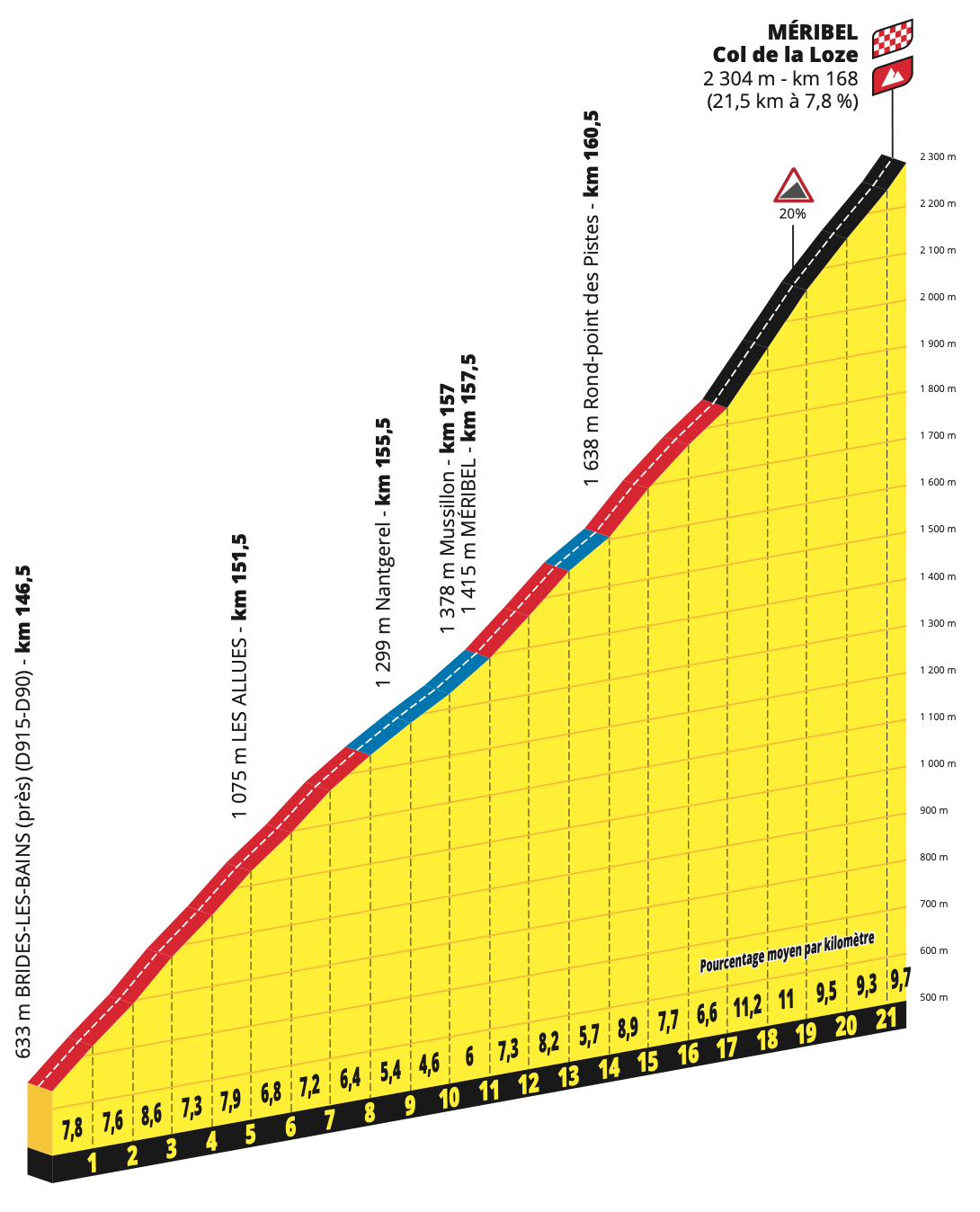
The Route: to get to the new climb, first take the old road. The D90 starts from Brides-les-Bains in the Savoie départment of France and goes to Méribel. Along the way, at the only roundabout, ignore the signs for Méribel-village and go right for the ski station. Once in the resort of Méribel follow the signs for the Rond-point des Pistes and the Altiport. The final 7km are on the new Montée de la Loze cycle path. In total it is a 21.5km climb with an average gradient of 7.8%.
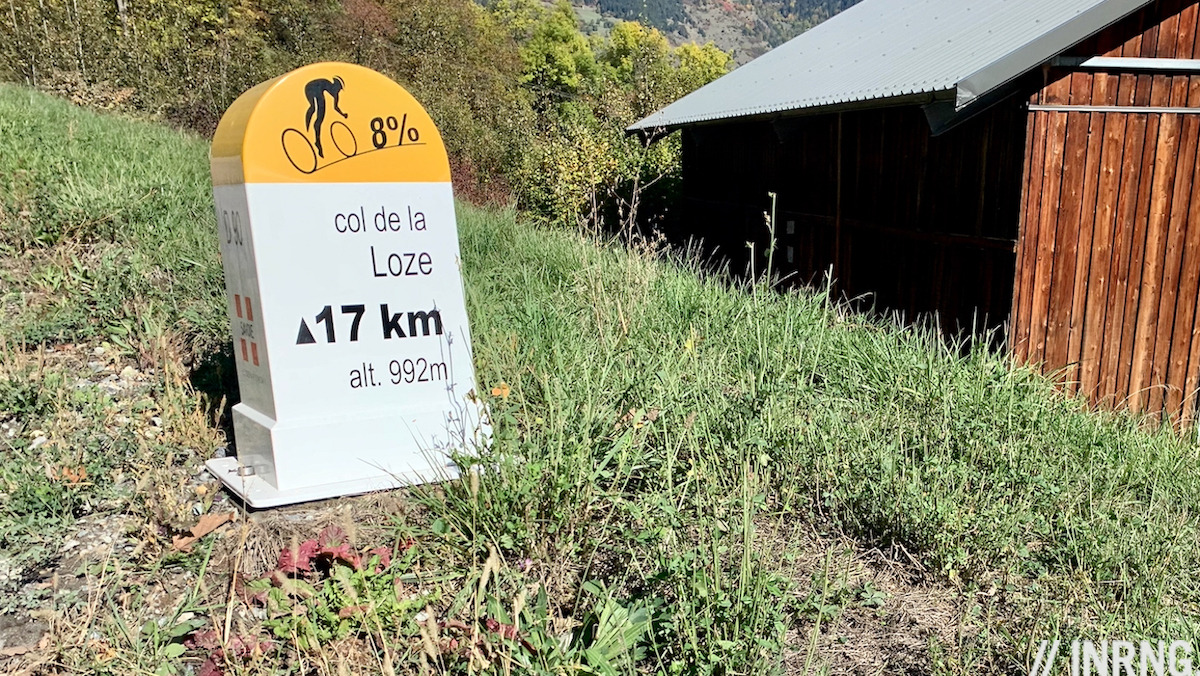
The Feel: mountain passes all over the Alps now have markers every kilometre telling cyclists the average gradient ahead. Here the early ones warn of 8% again and again so the start is no picnic. Still the road is wide and there’s new tarmac to help you climb fast. Tarentaise cattle, bells jangling, graze beside the road. It’s pleasant but not picture-postcard scenery, it vibes ski station access road thanks to the amount of buildings and street furniture. More scenic is the ridge of mountains high above topped by the serrated peak of the Dent de Burgin, a world away.
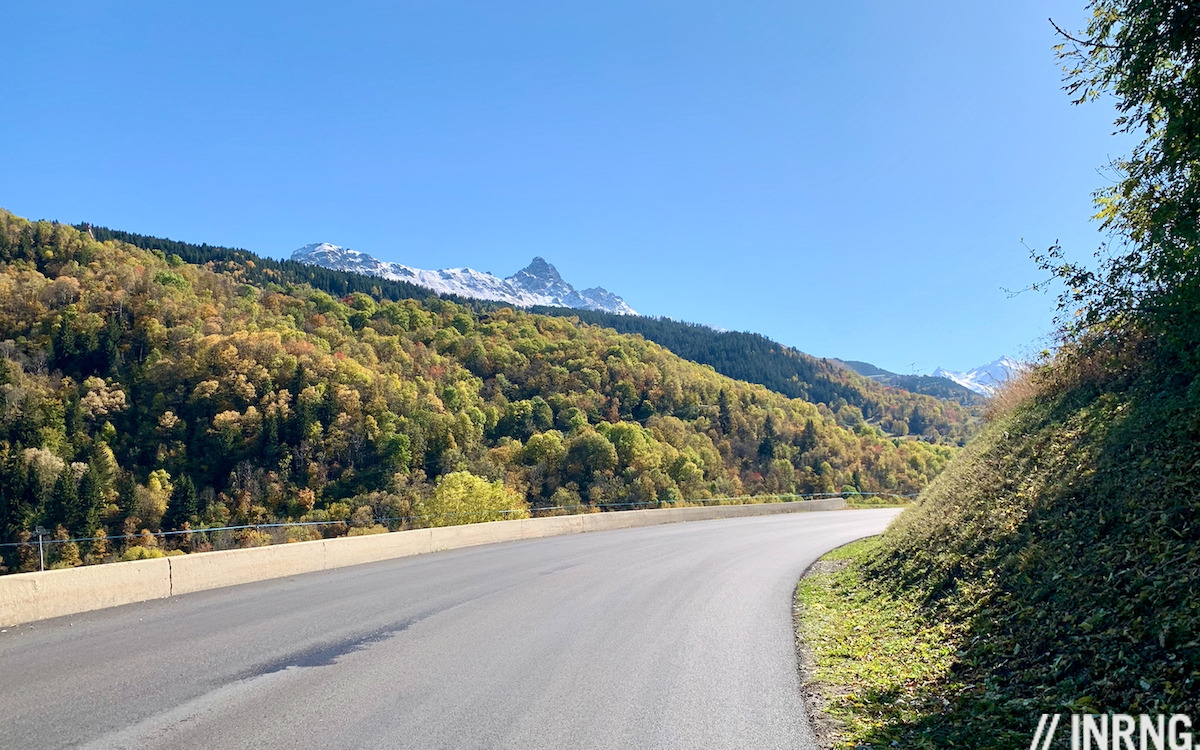
As a ski resort, Méribel’s not big but it’s still a town to pedal through when you came for the great outdoors. The Col de la Loze is brand new, aim for the Rond-Point des Pistes and look for the Loze cycle path.
The first impression of the new road is instant: an urgent need to change down as many gears as possible as there’s a really steep ramp to clear. Once you’ve crested this brief obstacle there’s a double-take as you realise you’re not on a road but cycle path reserved for cyclists and hikers.
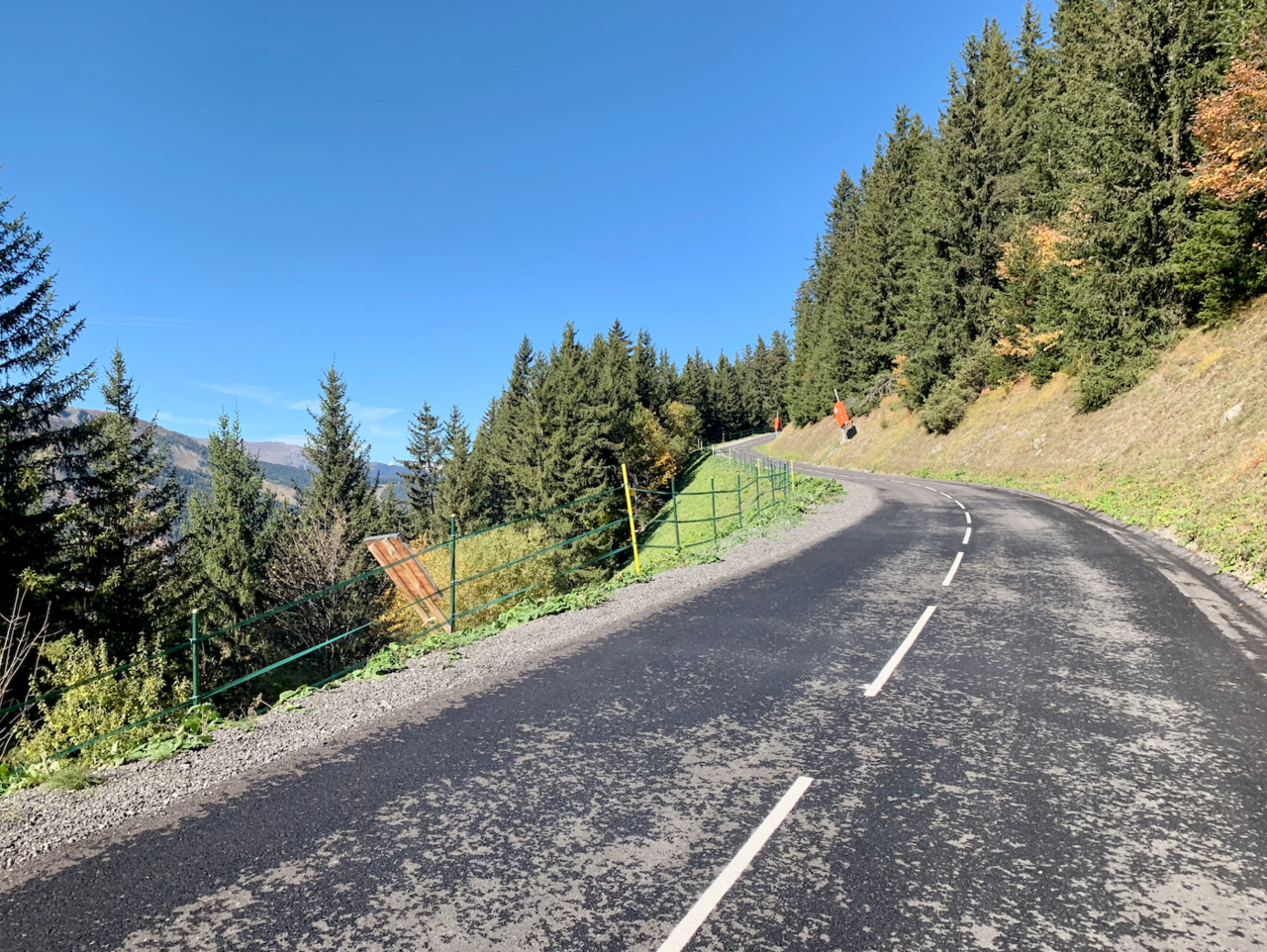
Having glanced at photos online things looked normal with fresh tarmac and a dotted white line down the middle: just like any other road. Only it’s a question of scale and there’s a Lilliputian feel as the road you thought you saw turns out to be cycle path little more than three metres wide. You ride past snow cannons, this is a ski run during winter. After a kilometre there’s a tight hairpin and suddenly you’re confronted with road rearing up in the woodland. The first thought was along the lines of “this is crazy, never mind racing up, it’ll be hard work in a team car” and images of team managers pumping clutch pedals and working gear sticks. From here the climb turns into something unlike anything else in the Alps. It’s confounding as there’s fresh, high quality tarmac but the slope keeps changing like a mountain bike course. There’s a section at 22% before it flattens out for a few metres and then rears up again and from here on the changes of pace keep on coming. There are plenty of 15% ramps, plus hairpins and sharp corners. I’d have taken more photos but it was too steep to pull out a phone and didn’t want to put a foot down.
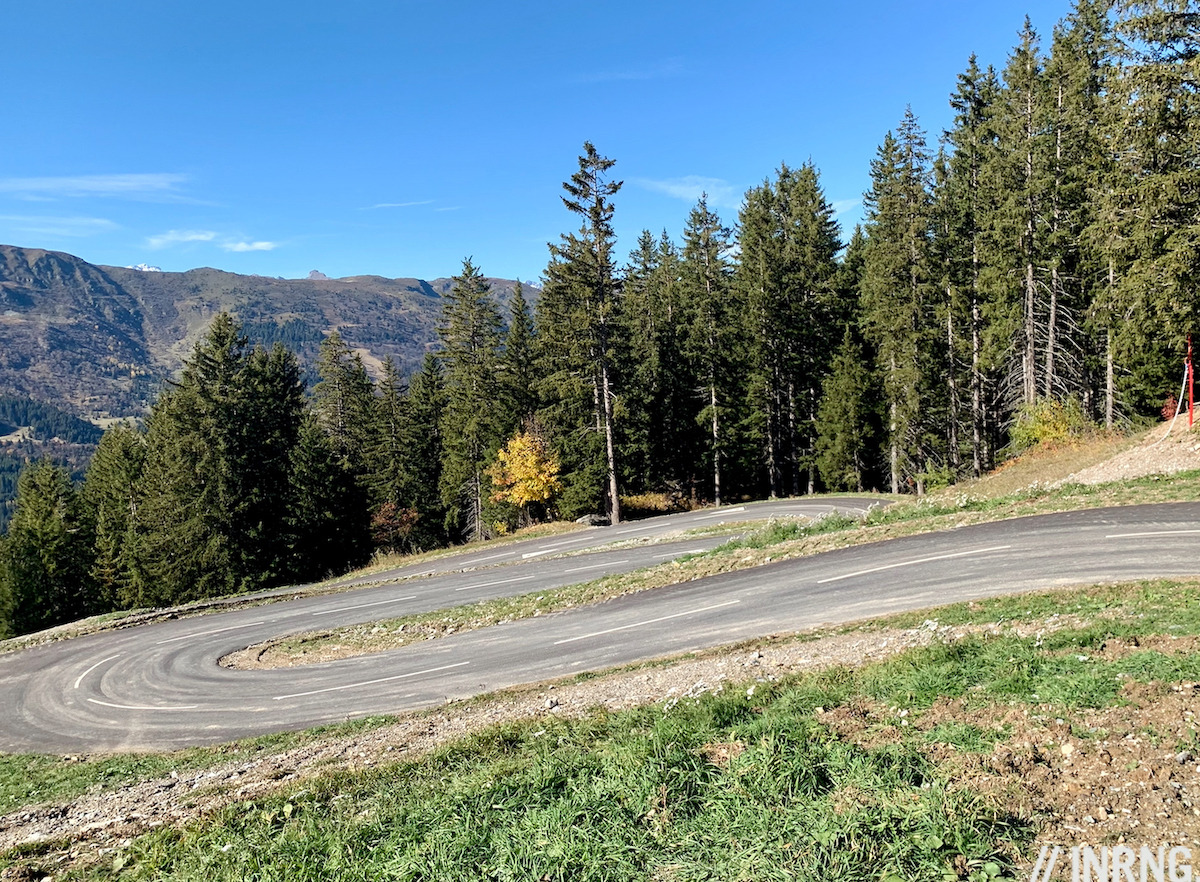
The Col de la Loze is a tarmac bucking bronco. It’s hard to get into a rhythm, the temptation is to power up the steep parts and recover in between, only you’re 2,000m altitude now and oxygen debt comes with a penalty interest rate. The secret is to use your gears a lot to level the effort out as much as possible but this assumes you’ve got with the right ratios because whatever you’d spin up the nearby Iseran or Cormet de Roselend you’ll be leg-pressing here. It’s not the Mur de Huy all the way up, the defining characteristic is the frequent, abrupt changes of slope, no profile graphic can capture this. As you ride past ski lifts the Dent de Burgin which earlier looked so far away is now so close it looks like the path is going to reach it.
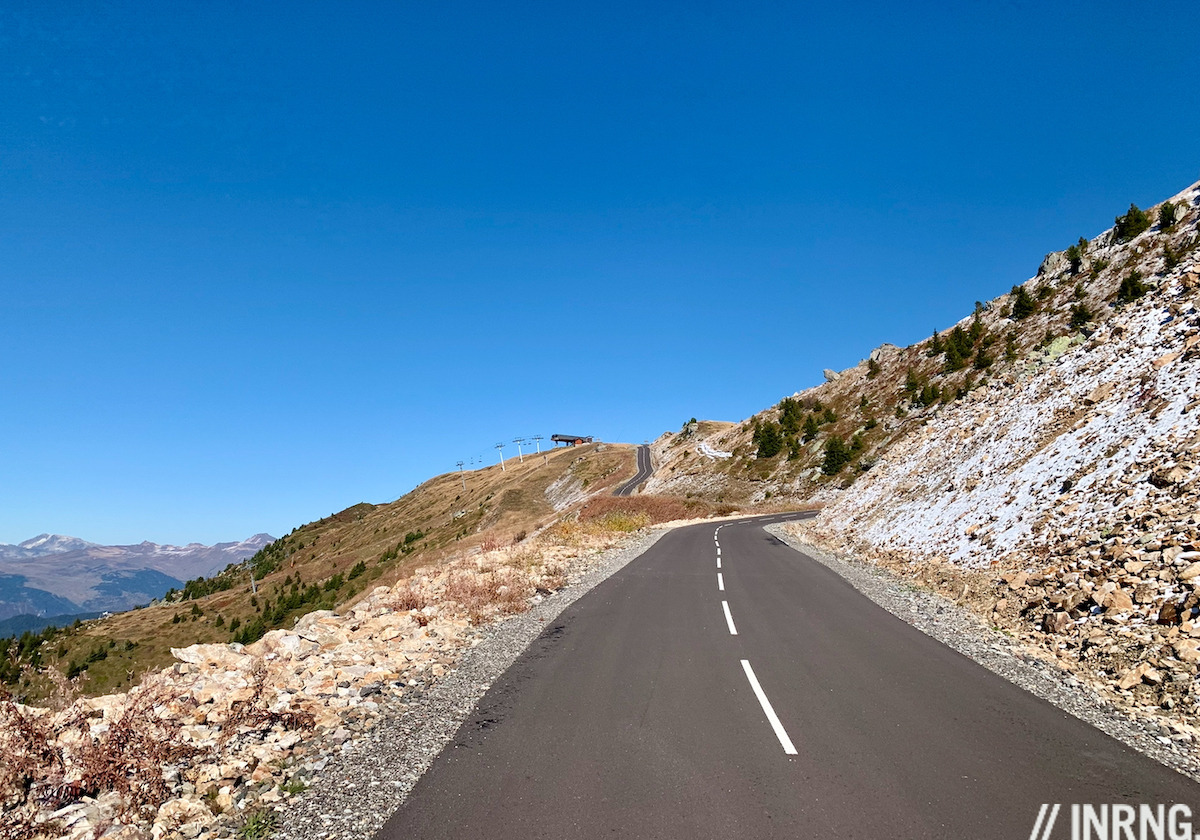
Then with about two kilometres to go you round a bend to point the other way. Here you can see the path as a long line ahead heading up towards the ridge. It’s less irregular and as you press on there’s even a descent to catch your breath. You can spot the final wall section from afar, a 20% just before the top. If this doesn’t take your breath away, the views at the top will. The ski resorts of Méribel and Courchevel are so far below you can’t see them, instead there are long views of the high mountains in 270°.
The Verdict: the road to Méribel starts with long 8% sections and good views but you’ll find the same kind of roads all over the region. Out of Méribel and everything changes thanks to the cycle path, narrower than a normal road. From here it’s 7.5km to the top and confounding with all the changes of pitch and with the altitude you need to measure your effort. It’s tough but you’re free to concentrate on the climb because it’s car free and the steep bits are short. It’s totally different to the usual Alpine experience.
What goes up: it’s a summit finish for the Tour de France but you can descend down the other side to Courchevel. The cycle path down the other side is wider and once it joins the main road follow the signs to Moûtiers to do a loop back to where the climb started. It’s not a great descent as you have to ride through Courchevel meaning traffic and but it’s the safer option compared to going back to Méribel. The narrow climb you’ve just tackled with tight bends and 20% sections is going to be awkward to descend.
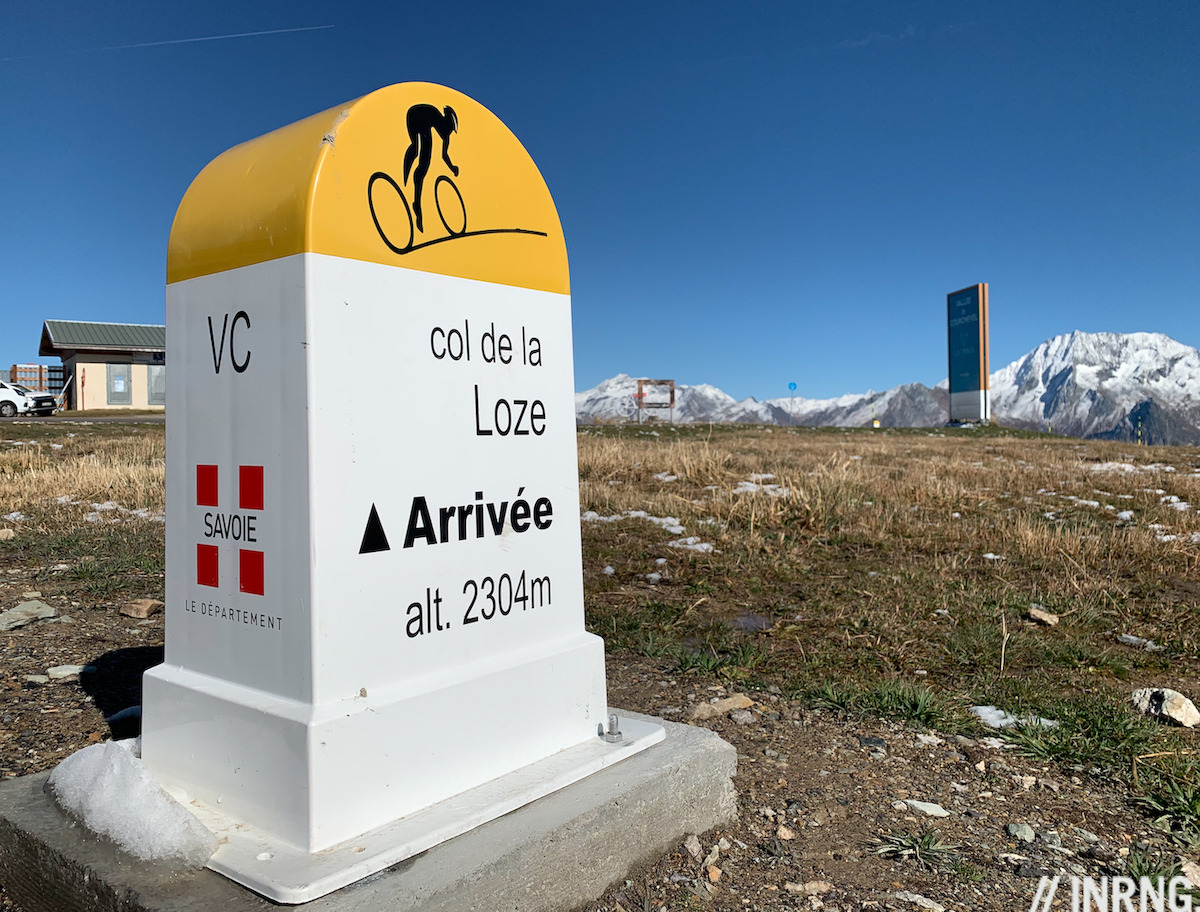
2274m or 2304m? The Col de la Loze may be freshly tarmacked but the pass is as old and listed at 2,274m. Now the new sign at the top of the climb says it’s 2,304m. Is this a touch of inflation, a push beyond the 2,300m barrier? It happens, the nearby Col de la Madeleine has a boastful sign declaring 2,000m when it’s actually 1,993m. Here the difference is that the geographic Col de la Loze is actually at 2,274m but you ride past this to reach the top of the road at 2,304m before descending. So the pass is 2,274m but the climb is 2,304m. Either way it’s now the eighth highest tarmacked mountain pass in France.
Why? Ski resorts want to be resorts, to enjoy a lucrative summer as well as winter. Attracting cyclists is one way to do this, Alpe d’Huez is already a Mecca for road cycling tourism and several ski resorts compete to be the Downhill MTB paradise. The Loze is only “Stage 1” of the Via 3 Vallées with plans for a new path to cross from Méribel over to Val Thorens, and then a link to the Maurienne valley which opens up a route for extreme Alpine cycle tourism.
On top of this is the e-bike boom. Many resorts have fleets of electric bikes and now a family of four will be able to tackle a “legendary Tour de France climb” before lunch, and all on a car free road. Still, you do wonder about inexperienced people being assisted all the way up and then having to descend the 20% twisty slope on a 15kg bike… perhaps the Loze chairlift works to take people back down safely?
History: the Tour de France last visited Méribel in 1973 for a finish inside the town at around 1,700m and Bernard Thévenet won the stage. The race hasn’t been back since. In August 2019 the Tour de l’Avenir rode up the freshly-surfaced Col de la Loze and footage on youtube lets you see some details:
- at 0m10s: the width relative to a car
- at 0m43s: the steep ramp to 150m to go, the flat section and then another ramp up to show the changing gradients
- the yellow jersey Mauri Vansevenant zig-zagging over the road at 1m04s
- Alexander Evans (Australia) wins the stage
Ride more: Méribel and Courchevel are now linked but are towards the end of their respective valleys. Nearby Moutiers and Salins-les-Bains sit at the foot of the valley and offer riding in several directions with the Madeleine, Iseran and Cormet de Roselend within range, it has the making of a base for hardcore cyclists looking to rack up plenty of 2000m+ plus clubs, but at the expense of more charming climbs and villages. Helpfully there’s a new cycle path on parts of the valley too.
More roads to ride at inrng.com/roads

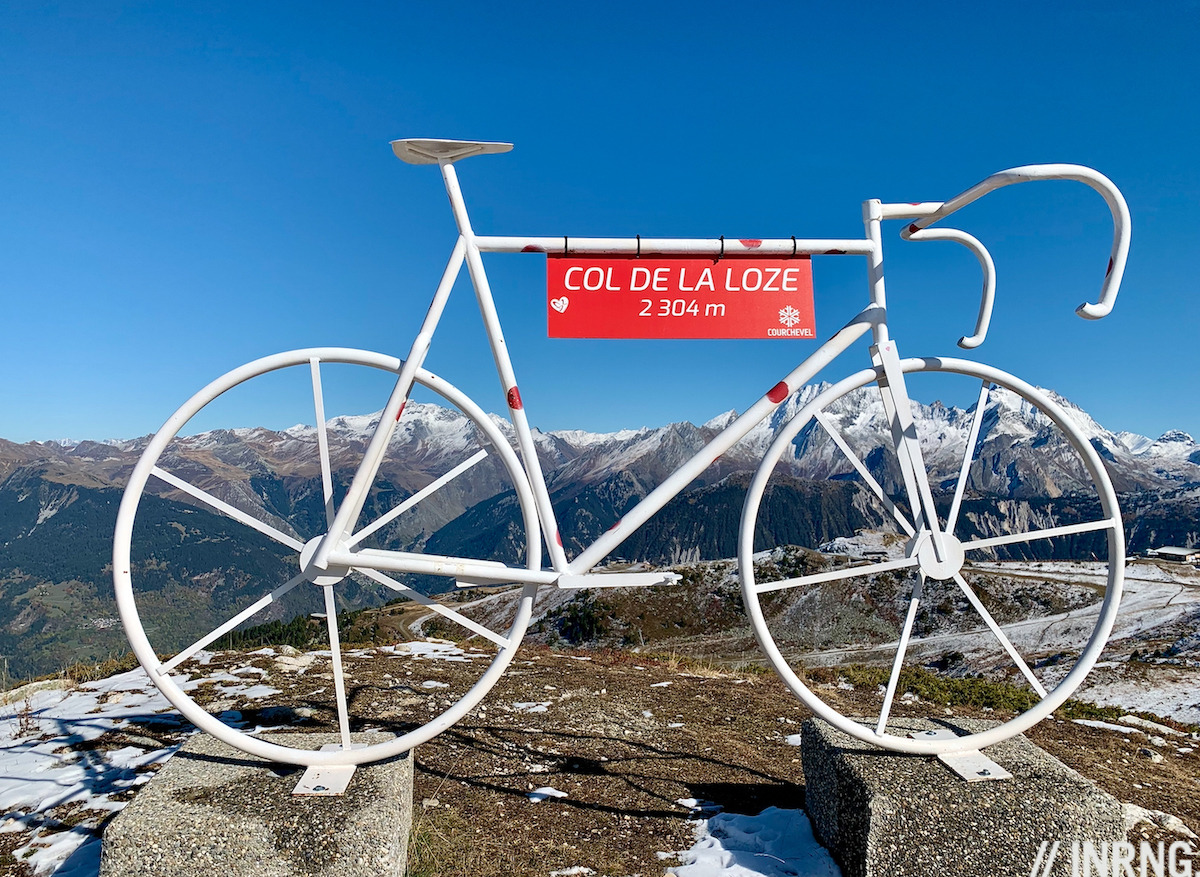
Thank you! Looks like you just now went and rode it?
“Now you could make it but imagine if you’re barrelling down a 16% section, round a bend and spot a rock in the road just as a cyclist is coming up the other way?”
Just jump! Over the rider obviously.
France does an amazing job at adding these climbs. I was told that Col du Sabot is scheduled to get paved on the north side as well, hopefully by 2021. (E-)Bikes only allowed.
https://www.google.com/maps/place/45%C2%B011'27.3%22N+6%C2%B006'36.2%22E/@45.19092,6.1078773,17z/data=!3m1!4b1!4m6!3m5!1s0x0:0x0!7e2!8m2!3d45.1909196!4d6.1100661
We’ll use it for our GFNY Alpes Vaujany.
The Sabot would be good, give visitors to Alpe d’Huez another big climb nearby.
My first thought is about spectators along the narrow bike path during the TdF. Even if the crowds aren’t three-deep, having a line of people along the path, in places where there is no shoulder, means people will be standing on the path itself, leaning into the path to see the oncoming riders. Now add a couple of riders up front who have just popped, a rider behind making a move by using them as a rolling roadblock, and a couple of riders behind trying to cover that move without a gap developing, all as the crowd is cheering and leaning in with their cell phones. I don’t think it ends well.
The whole reason Superman Lopez went down in that memorable scene this season wasn’t because a spectator ran along side him and ran into him. It was because there wasn’t room for two layers of spectators, so when one ran along with Lopez, another slightly further up the road was in the way, and responded by shoving the runner to keep from being knocked backwards.
This summit will certainly be exciting, but perhaps for reasons having more to do with the narrowness and less to do with the grades.
There’s room beside the path, it’s flanked by gravel as you can see but spectators will really need to stay on this and leave the road clear. In a way though they’ll have to as the lead car and other vehicles will plough a way though.
I’m thinking of the way that, even when there is a clear area off the road to stand, the spectators put one foot, and then two, on the road. They step back as the lead car and the cycles pass, and then step forward and lean in, almost as if the aerodynamic vacuum left by the vehicles pulls them into the road. The margin here is clearly much less. And if the crowd doesn’t step back quickly enough, we know that the car/motos will stop before hitting them, with the cyclists vulnerable to having a Froome-like crash into the rear of the vehicle that is supposed to be clearing the way.
I went back and watched the clip. I don’t think that road was “too narrow” – the fan was just an idiot – and got what he deserved. Imagine being the guy who got owned by tiny Lopez after his stupid antics…he got on TV, but not exactly in the way he’d planned. Perhaps the next idiot will think about it before getting in the way? We can only hope.
You’re alive Larry!
I’m not saying he’s not alive, but Larry’s comments here were made last autumn. Inrng reposted this article because of today’s stage.
Hope you’re well, Larry, if you read this!
He was back here the other day too.
Rode the other side, up from Courchevel, in the haute route this year and it was the toughest climb of the week. Overriding thought was, “who makes a bike-only road, this road?!”. Its just tarmac laid on the natural gradients of the mountain, like a roller-coaster in sections. It was properly enjoyable though and a real challenge. Has the potential for some great racing.
Looks like a great new test for the mountain goats. Allez le Tour
I think when you do these reviews of climbs you should start putting your time on!
That might just encourage him to race up. I think we want him going slow enough to be able to take in the surroundings.
Agreed. There’s already far too much phoney-baloney “competition” out there. Perhaps since I was never any good as a bicycle racer I’ve come to determine it’s not how fast you go, it’s how much fun you have.
I never said his time had to be fast..
So what would be the point of including this piece of meaningless data then? Don’t think Mr. Inrng is any sort of pro or ex-pro so whatever time he posted would just serve to be something others could boost their fragile egos by “beating”.
There is no virtue in being long-winded, but you can go too far if you are too keen to keep your one-liners shorter than they need be. If you had bothered to add why exactly you thought our host should put his times on or what you thought the benefit for his readership would be, I wouldn’t be posting this off-topic, stupid and inane comment (and Larry T wouldn’t have taken yet another opportunity to embarrass himself by opening his mouth).
PS I assumed your general idea was that the Inner Ring’s time would give us some sort of idea what an average Sunday rider’s time would be, but there are other and better ways, I would imagine.
PPS I quite like the Inner Ring’s ano- and pseudonymity, the fact that we don’t know his nationality, his age or where he lives, or indeed whether he is a he and not a she. I appreciate it whether it is simply because he wishes to keep his privacy or due to a loftier cause, a pursuit of wider, less nation-, team- or rider-centred views and opinions.
well it was intended as a bit of a joke but that obviously hasn’t gone well. I suppose if a time was put up it would give us an idea of how long it takes.
I didn’t think your comment was meant to be taken too seriously Richard, my reply wasn’t meant to be either.
On the assumption that Inrng is on Strava (why wouldn’t he be) then he could simply put the KOM and some mean or Mode time. That would probably give you the information you need.
If it helps it took the Tour de l’Avenir’s best riders just over an hour when they had a stage that started at the foot of the climb and ended at the top. Many Alpine climbs are 40 minutes, only a handful are an hour or more long.
Prefer if it’s all about the climb, the aim is to try and describe the road and area for visitors (and give more detail future race previews here) rather than do a write-up of how I got on a particular day.
Just out of interest how many times have you ridden it? Or did you just ride it after it was announced (or before as I assume you knew!) – was is a recent excursion?
Just once, last week.
Brrr. Must’ve been a little chilly up there last week.
It’s all south facing, so it was ok in the sunshine, there wasn’t much temperature difference over altitude, the descent on the northern side was colder with some damp and cool places where the sun couldn’t get to.
I am not sure I favor paving the north side of the Col du Sabot. I rode down the north side in 2008 on a road bike with 25mm tires and in some spots it was a real adventure! Not every road in the Alps needs to be paved for the lowest common denominator. Adventure is an experience that needs to be preserved as well!
I wondered if anyone else would express this sentiment. How many “epic” races have been held on unpaved roads over the decades? I can see the merits of this project for commercial purposes, but it might have been much more interesting to have ’em race over this before it’s paved.
There are still plenty of unpaved climbs to ride if the Sabot is done, see cycling-challenge.com for lots of suggestions or CCway where you can select unpaved climbs (“cyclable” in the filtres) field.
I wonder if any of the pros have read this, with it being a new climb I guess they’ll be doing all they can to find out more before getting the chance to recce it
Boy, that looks like it could be a doozy of a climb. That’s as long as Mt Ventoux (and 400 meters higher).
Now we need to get you to Switzerland some time, IR, to write up the Furka, Susten, St Gothard, and/or Grimsel Passes. Thinking about a trip to that region…
And the Worlds course above Martigny too, probably next on the list.
i dont think we will see anything new. Poss a breakaway by a couple of riders well down on gc but the usual suspects – Froome/Bernal will be there barring illness or injury poss Quintana(?). A stage for a lone attack or for a GC rider to cement his dominance
This stage sits in the middle of three tough mountain stages in the last week, and a couple of days prior to the TT, so it is likely to be GC action.
Pinot could go well on this climb?
It’s suits a rider who likes, or just copes better, with the changes in pace. Pinot’s often been a more steady climber but the final 2km level out a bit and suit a long sprint. Bardet and Barguil in their form of 2017 would like it, Froome if he can recover his form can spin up. Overall it’s more a climb where the likes of Dumoulin and Thomas aren’t so suited to the changes in pace but the differences are small, they can still try to manage the tricky sections.
Link to the Strava segment for anyone who wants a map: https://www.strava.com/segments/22066298